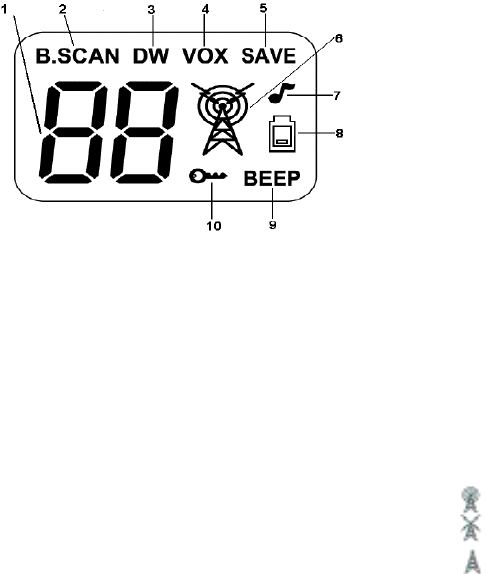Midland Radio F10 Family Radio Transceiver User Manual
Midland Radio Corporation Family Radio Transceiver Users Manual
Users Manual

Owner’s Guide
Model F-10 14 channel FRS
2
OPTIONAL ACCESSORIES FOR YOUR RADIO 2
PREPARATION 4
BATTERIES 4
To Install Batteries: 4
Low Battery Indicator: 4
Instructions for optional charger 4
QUICK USE INSTRUCTIONS: 5
Operating the Radio 5
TO OPERATE HANDS FREE VOX 5
Setting VOX Functions. 5
TO ENABLE / DISABLE VOX MODE 6
TO TURN THE RADIO ON OR OFF 7
TO CHANGE THE CHANNEL IN USE 7
ACTIVATING SCAN FUNCTIONS 7
Busy Channel Scan: 7
Open Channel Scan: 7
Activating Dual Watch 7
TO USE CALL BUTTON 8
TO ENABLE/DISABLE “ROGER-BEEP” 8
TO ENABLE / DISABLE KEY BOARD LOCK 8
POWER SAVE CIRCUIT 8
RESETTING THE RADIO 9
TROUBLESHOOTING 10
CARE OF RECHARGEABLE NI-CAD AND NI-MH BATTERIES 10
SERVICE: 11
CHANNEL FREQUENCIES 12
LIMITED WARRANTY 13
OPTIONAL ACCESSORIES FOR YOUR RADIO
Accessory Name Model Number
Standard Ni-Cad Charger ………………………………………..18-
Ni-Cad batteries ...........................................(Three Required)....18-
Lapel Microphone with Earbud Speaker………………………….22-405
Speaker/Microphone………………………………………….…...22-411
Stealth Type Noise Canceling Throat Mic with Earbud…………..22-430
Boom Microphone Headset ……………………………………….22-540
Call 1 816 241 8500 ext. 200 to order accessories
This device complies with Part 15 of the FCC Rules. Operation is subject to the
following two conditions: (1) This device may not cause harmful interference, and
(2) This device must accept any interference received, including interference that
may cause undesired operation.

3
Your Midland model F-10 brings the new FRS (Family Radio Service) to your
fingertips. The Family Radio Service is provided for by the FCC and is totally license
free. For the first time business and the general public can use the quiet UHF FM band
for personal communications at no charge. The F-10 uses maximum allowable power
for range up to 2 miles. Use for fishing, hunting, picnics, biking, business, or any other
activity where communications are needed for convenience or safety. The model F-10
operates on 14 channels to provide the best in quiet and private communication. Also
this radio offers power save, and auto-squelch.
WARNING
Your wireless hand-held portable transceiver contains a low power
transmitter. When the Push-to-Talk (PTT) button is pressed it sends out
radio frequency (RF) signals. The device is authorized to operate at a
duty factor not to exceed 50%. In August 1996, the Federal
Communications Commission (FCC) adopted RF exposure guidelines
with safety levels for hand-held wireless devices.
To maintain compliance with the FCC's RF exposure guidelines, this transmitter
and its antenna must maintain a separation distance of least 2 inches (5
centimeters) from your face. Speak in a normal voice, with the antenna pointed
up and away from the face at the required separation distance. The belt clip is
for storage purposes only. DO NOT TRANSMIT WHILE USING THE BELT
CLIP. To transmit, hold the device away from your body and ensure the
antenna is at least 2 inches (5 centimeters) from your body when transmitting.

4
TIPS FOR GETTING THE MOST FROM YOUR F-10
Due to the band of operation (462/467 MHz) the F-10 provides communications that
are virtually free of atmospheric interference (skip) that is common on lower
frequency bands. Along with this and an antenna system that is very efficient as
compared to other unlicensed radio bands, communications range is surprisingly good.
Many times the limits to maximum possible range are environmental factors such as
blockage caused by trees, buildings, hills, or other obstructions. If you find
communication is not possible, many times this can be overcome by moving only a few
feet to a new location. Range may be reduced while operating in a vehicle or from
inside to outside a metal building. Battery condition also affects range. The F-10
operates best on alkaline batteries. This unit is a precision piece of electronic
equipment that should not be exposed to water or handled carelessly. Normal care
should result in years of trouble free operation. Do not leave batteries installed over a
long period of time as leakage may occur that can destroy the radio. Always save your
receipt, as it is required for warranty consideration.
.
PREPARATION
BATTERIES
F-10 radios operate with 3 AAA Alkaline, Ni-Cad (nickel cadmium) or Ni-MH
(nickel metal hydride) batteries (optional). Ni-Cad batteries provide about 6 hours of
use. Alkaline batteries will provide about 18 hours of use and Ni-MH batteries will
provide about 13 hours of use. If the F-10 is supplied with Ni-Cad batteries and a
wall charger, Ni-Cad batteries must be charged prior to use. Charge at least 10 hours
with the standard charger. If you are using Ni-MH batteries charge at least 24 hours.
DO NOT attempt to charge any type of Alkaline batteries in this radio.
To Install Batteries:
Hold the radio face down. Press the latch so it swings away from the cover.
1. Lift the battery cover slightly. Gently slide the cover off the unit.
2. Insert 3 AAA batteries observing the proper polarity.
3. Replace the battery cover over the batteries and fasten with the latch.
Low Battery Indicator:
The battery icon in the lower left of the display will flash when the batteries are in
need of charging.
Instructions for optional charger
Install NI-Cad (nickel cadmium) batteries observing their polarity. Plug the 18-???
charger into any 110/115 V wall socket. Plug the cord into the jack on the SIDE of the
radio under the rubber plug marked “MIC/CHG”. Charge the batteries for at least 10
hours.
DO NOT attempt to charge any type of Alkaline batteries in this radio.
5
QUICK USE INSTRUCTIONS:
1. Install fresh alkaline or fully charged Ni-Cad or Ni-MH batteries.
2. Turn the unit on by turning the ON/OFF/VOLUME clockwise until a click is
heard.
3. Use the ON/OFF/VOLUME control to adjust the volume. To test the volume
setting, press and hold the “MON” button so static noise can be heard. The
noise can be used as a reference level for volume setting.
4. To talk press the PTT (push to talk) button on the left side of the radio and talk
in a normal voice into the front of the radio about three inches away from your
mouth.
5. To use “VOX” press and hold the “F/VOX” button for 2 seconds and talk into
the front of the radio or the headset microphone. (head set is recommended)
6. To listen release the PTT button. If in VOX stop talking.
Operating the Radio
TO OPERATE HANDS FREE VOX
(VOICE OPERATED TRANSMIT)
To get the most use from the “VOX” feature you must first determine what sensitivity
level is needed to activate the “VOX” control. Sensitivity is how loud you have to talk
to activate the “VOX” circuit. The “VOX” has three levels of sensitivity that can be
adjusted. The 1 option you can talk in a normal voice with no background noise to
activate the “VOX” circuit. The option 2 will require more voice level to activate the
“VOX” circuit. This is useful in slightly noisier areas that might activate the “VOX”
without talking. The option 3 will require the most voice level to activate the “VOX”
circuit. This will be useful in very noisy areas. The next adjustment is the delay. This
is a function of the “VOX” that keeps the radio in transmit mode after you stop talking.
A delay that is set to short will cause the “VOX” circuit to stop between some words.
The delay is adjustable to three levels. Level 1 will give about one half second of
delay, level three will give you about one and one half seconds of delay. By activating
the “VOX” you only have to talk into the front of the radio or use a headset to make the
radio transmit. The PTT (push to talk) button is not functional in “VOX” mode. It is
recommended to use a headset when using the “VOX” feature.
NOTE: It is recommended to disable the Roger Beep when VOX is in use. See page 8
for instructions.
Setting VOX Functions.
Setting VOX Levels
1. With the radio in the off position, press and hold the “CALL” button and turn the
radio on. When the radio powers up release the button The display will show “L”
followed by a 1, 2 or 3 depending on previous settings.
2. Press the channel “UP” or “DOWN” buttons to select the level desired.

6
! As described earlier L 1 will be the most sensitive and L 3 will be the least
sensitive.
3. Press the “F” button to switch to the Delay setting. A “d” followed by a 1, 2 or a
3 will show on the display depending on previous settings.
4. Press the channel “UP” or “DOWN” buttons to select the level desired.
! As described earlier d 1 will be the shortest and d 3 will be the longest delay.
5. Press the “ENTER button to store your settings and return to normal operation
mode.
TO ENABLE / DISABLE VOX MODE
Press and hold the “F/VOX” button on the front of the radio for 2 seconds.
Warning: When using the 22-405 or the 22-540 you must switch the VOX/PTT switch
to PTT to allow you to change channels or exit the vox mode.
DISPLAY SYMBOLS
CAUTION: DON’T EXPOSE THE DISPLAY TO EXTREME HOT OR
COLD TEMPERATURE
1. Channel number: Displays channel number 1-14.
2. B.SCAN indicates the scan mode B is in use. SCAN indicates the normal scan
mode is in use
3. DW Symbol: Indicates Dual Watch channel selection is active..
4. VOX Symbol: Indicates “VOX” is activated
5. SAVE Symbol: Flashes indicating battery save is active.
6. BUSY/TX Symbol:
When the radio is transmitting the icon will look like this:
When the radio is receiving the icon will look like this:
When the radio is in stand-by the icon will look like this:
7. Musical note indicates ROGER BEEP is on.
8. Battery symbol shows the battery condition. When this icon is displayed replace
or recharge the batteries.
9. BEEP indicates the button press tone and power up tones are active.

7
10. Key Symbol indicates when the keypad has been locked. Only the “PTT” and
“CALL” buttons are active when this indicator is on.
FEATURES AND LOCATION OF CONTOLS
TO TURN THE RADIO ON OR OFF
The ON/OFF/VOLUME control at the top of the radio controls power and volume. A
series of tones will be heard confirming that radio is working.
TO CHANGE THE CHANNEL IN USE
Press and release the channel button /\ or \/ to select the desired channel. To change
channel rapidly, press and hold the channel button /\ or \/ until the desired channel
appears on the display.
Warning: When using the 22-405 or the 22-540 you must switch the VOX/PTT switch
to PTT to allow you to change channels or exit the vox mode.
ACTIVATING SCAN FUNCTIONS
The F-10 has three scan modes. The most popular and most used is the “BUSY”
channel scan. This allows the radio to stop on a channel that someone is talking on.
When the radio stops on a “Busy” channel, the scan will stop and resume after about 5
seconds. The second is the “OPEN” channel scan. This allows the radio to stop on
channels that are NOT in use. This is useful when looking for open channels to use.
The third is “DUAL WATCH”. This allows you to scan only two channels. This is
useful when you want to keep track of two other people.
Busy Channel Scan:
1. Press and release the ”F” button the ”SCAN” icon (2) will begin flashing.
2. Press and release the “UP” or “DOWN” channel button to activate scan. The unit
will now begin scanning through the channels.
! Pressing the “UP” or “DOWN” channel button during scan will determine if
the channels are scanned up or down.
! Pressing the “PTT” (push to talk) button will cause the radio to stop scanning
and return to normal operate mode.
Open Channel Scan:
1. Press and release the “F” button repeatedly (usually twice) until the “B.SCAN”
icon (2) flashes.
2. Press and release the ”UP” or “DOWN” channel button to activate scan. The
radio will begin to scan for OPEN channels.(channels not in use)
! Scanning will stop on the first available open channel for about 5 seconds then
move to the next open channel.
3. Press the “PTT” button to stop scanning and talk on that channel.
4. To reactivate scan repeat steps above.
Activating Dual Watch
Dual watch is a function that allows you to scan only two channels.
8
1. Select channel one.
2. Press the “F” button repeatedly (usually 3 times) until “DW” (3) is flashing.
3. Select the second channel to be scanned.
! About 1 second after your selection of the second channel is complete the
radio will begin switching between the two channels.
! When the radio hears activity on either channel, scanning will stop on that
channel for about 5 seconds and then resume scanning.
! If communication is desired on the channel scanning stopped on, press the
“PTT” button. This will deactivate Dual Watch and allow you to communicate
normally.
4. To reactivate Dual Watch repeat steps above.
TO USE CALL BUTTON
Press and release the CALL button. A call signal will be sent for about 2 seconds.
Both radios must be on the same channel and the radios must be turned on.
"
""
" Warning: The call feature should be avoided when using the 22-405 or 22-540.
TO ENABLE/DISABLE “ROGER-BEEP”
The radio transmits a rapid tone sequence when the PTT button is released if this
feature is active. The default condition is for the “roger beep” to be off.
1. Press the “F” button (usually 4 times) until you see on the display “oF” or “oN”
(depending on previous programming) with a flashing music note (7) in the
display.
2. Press the channel /\ or \/ buttons to select off or on.
! “oF” is roger beep off. “oN” is roger beep on.
3. Press ENTER to store your selection.
! If no buttons are pressed for 10 seconds the display will revert back to
channel mode.
! The Roger beep should be deactivated when using the radio in vox mode.
TO ENABLE / DISABLE KEY BOARD LOCK
To enable the KEY BOARD LOCK press and hold the “ENTER” button for 2
seconds. The display will contain a key symbol (10). PTT, MON and CALL buttons
will still be active. The “ENTER” button will also activate the back-light for 5
seconds. When radio is in lock mode and any other keys are pressed a tone will be
heard. To disable the KEY BOARD LOCK, press and hold the “ENTER” button for 2
seconds.
POWER SAVE CIRCUIT
This part of the operation of the radio is completely automatic and not adjustable.
When the radio has not transmitted or received a signal for about 8 seconds it will
begin to cycle from a sleep mode to fully on. This occurs several times a second. If a
signal is received or you cause the unit to transmit the radio will become fully awake.
This cycling from sleep to fully on increases the standby battery life more than 50%.
9
RESETTING THE RADIO
If the radio stops responding to button presses or otherwise does not function properly
in some cases the radio can be reset to restore normal operation.
To reset the radio: With the radio off, press and hold the “F” button and turn the radio
on. Release the “F” button when the radio powers up. (see turning the radio on)

10
TROUBLESHOOTING
PROBLEM SOLUTION
No Power 1. Check battery installation and/or replace batteries
Cannot receive messages 1. Make sure the volume is set high enough.
2. Change your location, you may be out of range.
4. Install batteries properly or replace.
Range is short 1. Operating the radio in a vehicle or metal building
will decrease the range. If possible operate outside of
vehicles or buildings.
2. Carrying the radio so that the antenna is very near
the body will decrease the range. Hold the radio in the
open for the best range.
3. Battery condition can affect range. Replace or
recharge batteries.
Radio squeals when
receivnng messages 1. Check battery condition. Usually lowering the
volume stops the squealing. This indicates weak
batteries.
Messages not transmitted. 1. If PTT button is not responding, check to see if
VOX is active.
2. If VOX is in use, check for correct VOX level
setting.
Interference/Static 1. Change your location. The interference may be
caused by nearby electronic or electrical equipment.
Cannot change channels 1. Make sure keyboard is not locked.
2. Make sure the radio is not transmitting.
Battery icon flashes 1. Replace alkaline batteries or recharge rechargeable
batteries.
Display is dim Reposition or replace batteries.
CARE OF RECHARGEABLE NI-CAD AND NI-MH BATTERIES
ALWAYS DISPOSE OF BATTERIES PROPERLY
Always follow the battery manufacturers recommendations for charging and disposing
of Ni-Cad and Ni-MH batteries.
The following is meant as general information regarding Ni-Cad/Ni-MH batteries.
.
1. Occasionally allow the batteries to fully discharge before recharging. Full
discharge will be indicated by the low battery indicator coming on during receive
operation.
11
2. Always allow the battery to fully charge before using. This requires 10 hours with
the approved charger. (Ni-MH batteries require 16 hours for full charge.)
3. The above will prevent the batteries from developing “memory” which effectively
reduces their capacity.
4. It is better to store Ni-Cad batteries that are discharged rather than charged.
Ni-MH batteries are best stored charged.
SERVICE:
If you have a problem which you believe requires service, please call first and speak
with a service technician. Many problems can be remedied over the phone without
returning the unit for service.
If it ever becomes necessary to return your unit for service:
♦ Pack the unit in its original box and packing. Improper packing may result in
damage during shipment.
♦ Include a full description of any problems.
♦ Include a daytime telephone number.
♦ Include a money order for $7.50 to cover shipping and handling (this may not be
required in some states).
! You do not need to return accessory items (charger, batteries, wrist strap,
owners guide) unless they maybe directly related to the problem.
♦ Include a photocopy of the bill of sale or other proof of purchase showing the date
of sale. This information must be included before warranty service can be
considered.
♦ A flat rate of $35.00 will apply to repairs not covered by the 1 year warranty.
These items include but not limited to Abuse, Internally modified circuits, damage
caused by water , battery leakage or liquid spilled into the radio.
♦ Payment is accepted by Cashiers Check, Money Order, Master Card or Visa only.
Personal checks will not be accepted.
! Items not covered by the warranty include abuse, water damage, battery leak
damage, broken antennas, broken battery latch

12
TECHNICAL SPECIFICATIONS
TECHNICAL SPECIFICATIONSTECHNICAL SPECIFICATIONS
TECHNICAL SPECIFICATIONS*
GENERAL
Frequency range..................................................................................462/467 MHz
Channels...............................................................................................................14
Modulation type................................................................................................. FM
Antenna impedance ....................................................................................50 Ohm
Loudspeaker.........................................................................................8 Ohm 0.5W
Microphone...................................................................................…...electret type
Power supply..........................................3 AAA Ni-cads or Alkaline (3.6/4.5VDC)
RECEIVER
Sensitivity at 12dB Sinad..............................................................................0.25µV
Selectivity........................................................................................................50 dB
Squelch range...................................................................................…....automatic
Audio output power...........................................0.25W @ 8 Ohm (10% distortion)
Distortion at 1000 mV.........................................................................................7%
Audio frequency response.....................................................................400-2400 Hz
TRANSMITTER
RF Output Power...........................................….…….nominal 500 mW @ 4.5VDC
Frequency Tolerance.................................................................................0.00025%
Harmonic Suppression...................................................................more than 50 dB
Modulation......................................................................................FM +/- 2.5 kHz
*Specifications are nominal and subject to change
CHANNEL FREQUENCIES
01=462.5625 05=462..6625 09=467.5875 13=467.6875
02=462.5875 06=462.6875 10=467.6125 14=467.7125
03=462.6125 07=462.7125 11=467.6375
04=462.6375 08=467.5625 12=467.6625

13
LIMITED WARRANTY
Midland Consumer Radio Inc. will repair or replace, at its option without
charge, any Midland FRS transceiver which fails due to a defect in material or
workmanship within One Year following the initial consumer purchase. This warranty
does not apply to water damage, battery leak damage or abuse.
This warranty does not include any carrying cases, earphones, or antennas
which may be a part of or included with the warranted product, or the cost of labor for
removal or re-installation of the product in a vehicle or other mounting.
Performance of any obligation under this warranty may be obtained by
returning the warranted product, freight prepaid, along with proof of purchase date, to
Midland Consumer Radio Inc., Warranty Service Department, 1670 North Topping
Avenue, Kansas City, Missouri 64120.
This warranty gives you specific legal rights, and you may also have other
rights, which vary, from state to state.
Note: The above warranty applies only to merchandise purchased in the United States
of America or any of the territories or possessions thereof, or from a U.S. Military
exchange.
Midland Consumer Radio
1670 N. Topping
Kansas City, Mo. 64120-1224 Printed in Korea
Tel: (816) 241-8500)
E-mail: mail@midlandradio.com
URL: www.midlandradio.com